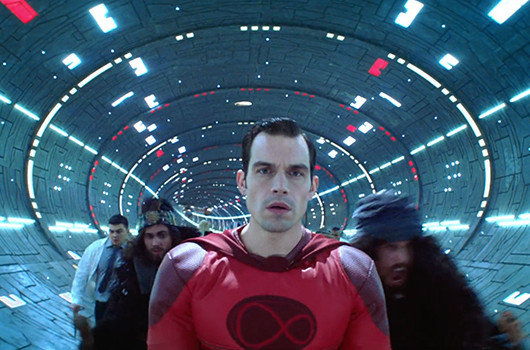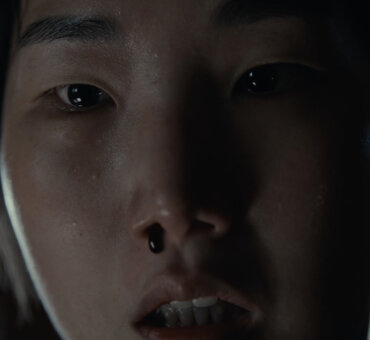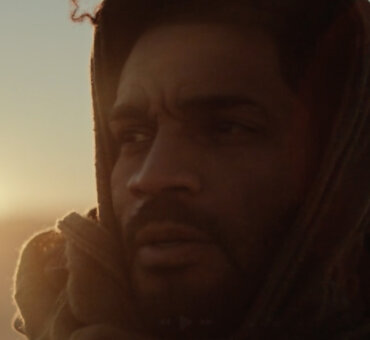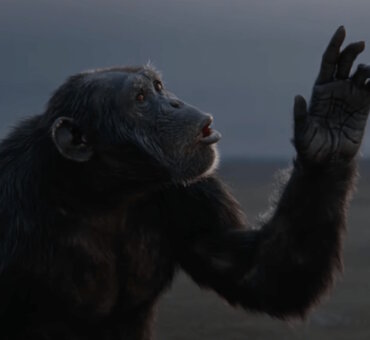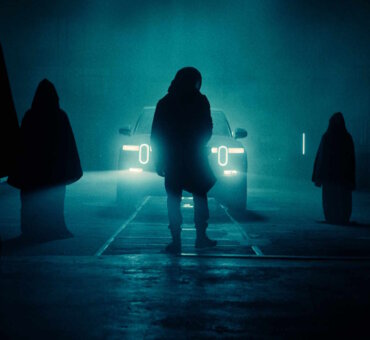Rogue Films’ latest commercial for Virgin Fibre, “Delivering Awesome,” is a breakneck joyride through a fiber optic cable, featuring a mash-up of every character and character type you can imagine. Cowboys. Superheroes. Dandies. Dames. Rather than relying entirely on computer graphics to create this beautiful, surrealistic spot, director Sam Brown did things the old-fashioned way: he built a giant tunnel and raced cars through it. The result is one of the most exhilarating ads you’ll see this year. Watch it below, then read our Q&A with Sam about how he pulled it off.
Why build a real tunnel rather than just CGI? What’s the value of doing practical effects?
It’s nice to do things for real, if you possibly can. Quite often it will be more expensive, so you need a good reason for doing it. But generally, amongst filmmakers there’s been a kind of voguish shift back to doing things in-camera, which I think is healthy. Most of the top post-production people I work with will maintain they’d rather start with something in-camera and build their magic on that. It makes everything more tactile, solid, and real.
Also, I’m big on accidents. If you’re doing something real, you tend to screw up more. The camera moves feel a little bit more organic and spontaneous, and you make discoveries on the day that you weren’t anticipating in the planning. This is where so many interesting moments come from in filmmaking: the accident of performance, movement, or lighting that you end up jumping on and developing. Post-production tends to be so meticulous and deliberate, so I think it works better when you anchor it to something imperfect.
The other thing is that, while audiences can be extremely visually articulate and sniff out bad CGI as quickly as any director, I’m not sure they care about it all that much. Which is to say that what matters most to the audience is the storytelling. How good the CGI was probably sits way down on the list. The Wizard of Oz is still as fresh and watchable now as it ever was, and nobody is calling out the primitive SFX in Back to the Future. The brilliance of the story and the characters in those movies is everything. The other stuff is in the background just helping it out and doing what it needs to do.If the cosmic tunnel sequence in 2001: A Space Odyssey were done now, it would be much more sophisticated. But would it feel as stunning as the original? My guess is it would be slick, overworked, and somewhat forgettable. Yet Kubrick used the comparatively primitive tools and technologies at his disposal to create an iconic and indelible sequence that we still talk about now. You feel the same thrill watching it today as audiences felt then.
Conversely, if you think about it, there are very few examples of post-heavy films that are actually good or enduring. It’s not just that they’re visually soulless. It’s more that all the love and attention tends to go [into post-production] because the demands and requirements of shooting a big CGI movie are so huge. Everything else gets sidelined almost by necessity.
So, really, the idea of building a real tunnel comes down to what makes the audience forget about this aspect of filmmaking the quickest and concentrate on the story we’re trying to tell. If the tunnel is real, then the shadows, lighting, and footfalls are all real; and there’s a ton of incredibly complex issues I don’t have to think about in favor of more important stuff in pre-production.
It’s also nice, of course, to be able to bring your actors into a real location. It’s easier to put them into your world because then you don’t have to describe it to them. It’s there and they can feel it. And if they can feel it, then most likely the audience will too.
Which shot was the most difficult to achieve? And how did you achieve it?
The toughest aspect of the shoot was how short the window of opportunity was for filming. The tunnel was only 200 feet long; so at the speeds we were filming, that gave us only a few seconds of opportunity. And once we discarded the first and the last sections of the tunnel as being inadequate for lighting, you’re suddenly in and out of the tunnel in a flash. So coordinating everything to work in that split second was very tough. You’re looking for little bits of gold in very complex setups. And if you don’t happen to find them, the reset time to go around again is brutal.
The other hard thing was the handful of shots that safety dictated we had to do against a green screen. Matching the lighting meant reconstructing sections of the tunnel in CGI, and then projecting this through LED panels that we used as our primary light source. In this way we made sure all the lighting on the characters moves in the same way.
This is a great example of how I like to use post. We want it to be real enough not to jar with anything else, but I’m not looking for a painfully authentic result. What’s happening in terms of the actors at that point is the key. Everything else is background.
Was this piece as fun to shoot as it looks? Is it important for shoots to be fun?
Yes, it was fun. Shooting should always be fun! Of course, there are a million situations that will conspire to make it not fun. And, frankly, sometimes you feel like you’re losing your mind, and you want to slope off and cry privately behind some scenery. But I’m a genuine believer in the process: that the act of making something is as important as the film you get at the end. From the beginning I’ve been conscious of the fact that beyond the small community of people who have a creative stake in what I’m doing, there’s a wider crew who won’t be so invested in the end result, but they will care very much about how they’re spoken to and treated when we’re working together. I try to consider what will give them a reason to turn up and bust their guts for me again the next day. You set the tone as the director. I consider it part of my job to get that right.
I also know that how much you like a film can depend on how much of a pleasure it was to make. I hear this from creatives all the time. A film can turn out brilliantly; but if it was a nightmare to birth, they find it really hard to love. I understand this because I feel the same way. You don’t see the shot like the punter will; you see the horrendous process behind making it.
Were there any lessons learned while making this spot?
I learn something on every spot — and not always about film. On this one I learned something brilliant about human nature, which is that people wearing the same kind of theatrical costume tend to stick together off-camera and develop a strong camaraderie that they never would have in their everyday clothing. Everything gets very tribal. Over the shoot days they start acting like their costumes, quite naturally: the barbarians eat like animals at lunch break, whereas the dandies are incredibly fussy and snippy about the food. And nobody sits anywhere near the Mad Max guys. It’s kind of hilarious.
For more behind-the-scenes VFX action, check out these related articles:
How Convolv Launched a Rocket for Chump Change
